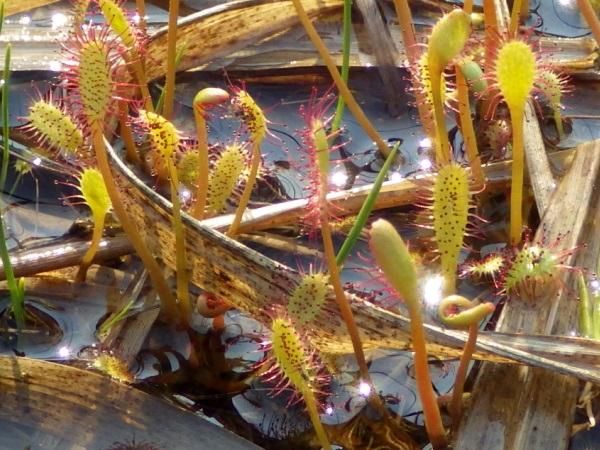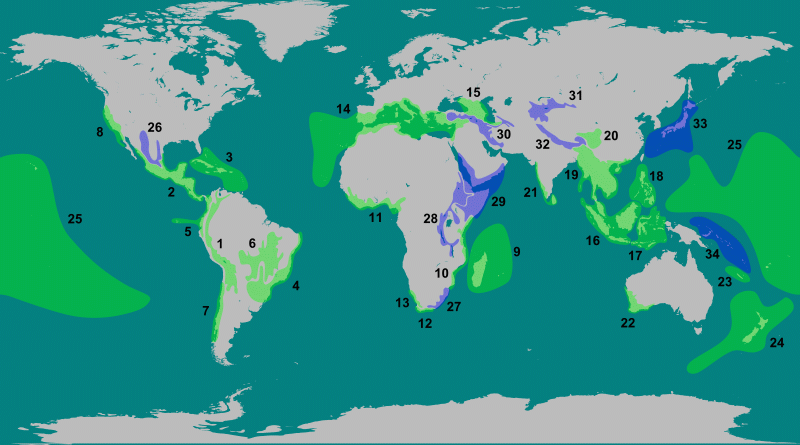(Upload on February 10 2013) [ 日本語 | English ]
Mount Usu / Sarobetsu post-mined peatland
From left: Crater basin in 1986 and 2006. Cottongrass / Daylily
HOME > Lecture catalog / Research summary > Glossary > Conservation
[ naturalness | endangered species | hotspot ]
Conservation (保全)Human ecosystem (生態系) and the environment (環境) (Mader 1985)lead to environmental problems. Land use: urbanization, cropland and rangeland, etc. + Pollution Human activities are causing the extinction of many different kinds of organisms (species).Humans are beginning to learn how to work with nature for a better environment ⇒ conservation (保存・保護・涵養) = preservation (保存・保全・保護) and/or conservation and/or reclamation Conservation biology (保全生物学)The studies on the nature and status of biodiversity at varous scalses for conserving species, habitats, and ecosystemsConceptual termsKeystone speciesUmbrella species Foundation species: strong role in structuring a community (often dominant species in the community) Conservation ecology (保全生態学)Ecological approachblend natural processes with reclamation decision (succession, competition, grazing etc.)create landscapes managing natural elements create complementary species assemblages - mosaic nature maximize use of existing site qualities/species expand conservative areas Ex. Heath (s.l.): meaning that harsh, alpine vegetation dominated by Empetrum nigrum, etc. in the case of Japan
Decrease in Scotland forests and development of heath Oceanic climatic condition → cool and humid summer and warm in winter
List of major plants in heath, most of which are less than 1.5 m in height |
England: vascular plants = ca 1570 taxa (= a half of Japan, and close to Hokkaido) Landscape conservation (景観保全)reclamation (回復・取戻): return to productive userehabilitation: improve derelict land restoration: return to a complete, natural system  Terminology
Terminologyreservation (保留・保存) nature reserve (自然保護地) conservation of natural resources (天然資源の保存・保護) |
| Flora and fauna | Development of vegetation and soil | Examples | |
| Natural landscapes | Spontaneous | Not influenced by man | Parts of the Wadden area (mud flats, coastal beaches, and salt marshes) |
| Subnatural landscapes | Completely or largely spontaneous | To some extent influenced by man | Parts of the dune landscape, most salt marshes, inland drift sands, deciduous woods with some cutting, final stages of succession in hydroseries in fens |
| Seminatural landscapes | Largely spontaneous | Drastically influenced by man (other formation than the potential natural vegetation) | Heathlands, oligotrophic grasslands, sedge swamps, reed swamps, inner dune grasslands, coppice, osier beds, many woods in which the tree stratum is arranged by man |
| Agricultural landscapes | Predominantly arranged by man | Strongly influenced by man (soil often fertilized and drained; vegetation with ruderals, neophytes, and garden escapes) | Arable fields, sown grasslands, parks, conifer forests |
| Naturalness | Hemerobiotic state | Changes substrate | Changes vegetation structure | Changes floristic composition | Loss natives (%) | Gain neophytes (%) |
| Natural | A-hemerobiotic | No | No | No | 0 | 0 |
| Near natural | Oligo- | Few | No | Most species spontaneous | < 1% | 5% |
| Semi-(agri)-natural | Meso- | Small, superficial | Other life form dominating | Most species spontaneous | 1-5% | 5-12% |
| Agricultural | Eu- | Moderate to drastic | Crops dominating | Few species spontaneous | 6% | 13-20% |
| Near-cultural | Poly- | Drastic artificial substrate | Open ephemeral | Few to no species | ? | 21-80% |
| Cultural | Meta-hemerobiotic | Drastic artificial substrate | - | - | - | - |
|
(s.l.) A population of species which is at risk of becoming extinct, because it is either few in numbers, or threatened by changing ecosystems |
(s.s.) taxa in danger of extinction and whose survival is unlikely if the causal factors continue operating. Included are taxa whose numbers have been reduced to a critical level or whose habitats have been so drastically reduced that they are deemed to be in immediate danger of extinction. Also included are taxa that are possibly already extinct but have definitely been seen in the wild in the past 50 years |
|
Red Data Book, RDB: source books that record endangered plants and animals, not only published by IUCN Red Data species, RDS: endangered species assigned by International Union for the Conservation of Nature and Natural Resources, IUCN (2008)
|
|
Hokkaido (北海道)
Mammals (哺乳類)Most of them are endangred in HokkaidoVascular plants (維管束植物)*: distributed in Sarobetsu mire (サロベツ湿原) → wetland (湿原)Aconitum ito-seiyanum (セイヤブシ), R (Hokkaido) Betula apoiensis (アポイカンバ), CR Betula davurica (ヤエガワカンバ), NT Carex bigelowii (オハグロスゲ), DD Carex nemurensis (ホソバオゼヌマスゲ), VU |
Carex rhynchophysa (オオカサスゲ), CR Cirsium apoense (アポイアザミ), CR Crepis gymnopus (エゾタカネニガナ), VU Drosera anglica (ナガバノモウセンゴケ)*, VU Erigeron thunbergii var. angustifolius (アポイアズマギク), CR Hypochaeris crepidioides (エゾコウゾリナ), EN Iris laevigata (カキツバタ)*, VU Lonicera chamissoi (チシマヒョウタンボク), VU Pogonia japonica (トキソウ)*, NT Rumex longifolius (ノダイオウ), VU Salix arbutifolia (ケショウヤナギ), VU and more |
Metagenomics (メタゲノミクス)≈ environmental genomics, ecogenomics and community genomicsThe study of genetic material recovered directly from environmental samples Metagenome (メタゲノム)Operational taxonomic unit, OTU1. RarefactionE(S) = Σi=1S(1 - N-NiCn/NCn)
E(S) = number of expected species at n 3. Hypothesis examined by statistics |
ApplicationsInfectious disease diagnosis(Gut) microbe characterization Biofuel Environmental remediation Biotechnology Agriculture Ecology Tax4Fun (Aßhauer et al. 2015) and other methods: by using 16S rRNA metagenomic data, the characterization of phylogenetic and functional diversity - R package Amplicon sequence variant, ASV≈ exact sequence variants or zero-radius OTUs (zOTUs)Methods DADA2 Deblur MED UNOISE |
|
biodiversity = biological diversity, proposed by Wilson & Peter (1988) The totality or total complexity of genes, species, and/or ecosystems in a various scales from habitat to the world. |
Table. Biodiversity should be considered with three levels.
|
 Featuring exceptional concentrations of endemic species and experiencing exceptional loss of habitat (Myers et al. 2000) |
Based on the number of endemic species > 1,500 species 2000 (established): Bonin Islands only 25 hotspots (Area = 1.4%) → 44% vascular plants / 35% vertebrates 2005 (revised): the whole of Japan 34 hotspots (Area = 2.3%) → 50% vascular plants / 42% vertebrates The twenty-five biodiversity hotspots (green, coded as 1-25) prorposed by Myers et al. (2000) and added nine hotspots (blue, 26-34) (Mittermeier et al. 2005) |
|
|